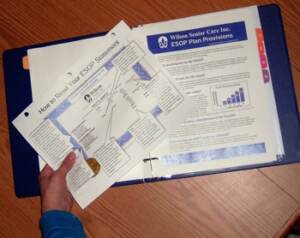 Providing statements to ESOP participants can become as routine as a scheduled train – coming and going without any thought to its significance. The truth is this routine requirement can be a huge opportunity to switch employees’ “train of thought” to the benefits of shared ownership in your company. Rather than a routine requirement, you can make this required communication a tool for achieving your overall communication objectives. This article provides three very different examples of ways that Workplace Development helps client companies to use the annual statement to get their communication train on the right track.
Providing statements to ESOP participants can become as routine as a scheduled train – coming and going without any thought to its significance. The truth is this routine requirement can be a huge opportunity to switch employees’ “train of thought” to the benefits of shared ownership in your company. Rather than a routine requirement, you can make this required communication a tool for achieving your overall communication objectives. This article provides three very different examples of ways that Workplace Development helps client companies to use the annual statement to get their communication train on the right track.
Develop more business knowledge
“We want everyone to be more aware of how they affect our ESOP and the business’s success,” says Ali Jamshidi, CTL Engineering’s CFO. The annual ESOP statement is part of the firm’s educational process. Rather than just mailing out statements, CTL holds small-group meetings to explain the statement and enhance employees’ business knowledge. Workplace Development provides customized presentation materials, behind the scenes coaching and hands-on activities that enable company leaders and ESOP Committee members to explain how the ESOP benefits “me,” the key drivers of company success and how employees affect the business.
“We know our business, but most employees cannot see the whole picture from the job-level,” says Jamshidi. “The statement presentation educates our employees on the importance of serving clients, reducing debt and strengthening profitability and cash flow. Improving those things benefits all of us as we grow the company’s value.”
Provide a reason to learn more about the ESOP
For Wilson Senior Care, the participant statement provides a good reason to open up the Owners’ Manual to learn more about the ESOP. “Employees are working with residents and their families 24 hours a day, 7 days a week,” says Dennis Lofe of Wilson Senior Care. “We need something that they can refer to that is accurate, understandable and reflects the real meaning of our ESOP.”
Company leaders worked with Workplace Development to create an ESOP Owner’s Manual which uses the participant statement as a focal point for learning. It includes a visual explanation of how to read the statement, required communication, plus short explanations of plan rules and what the ESOP means for employees and the surrounding community. The Manual — which includes pockets to hold the annual ESOP statements employees receive — is part of a comprehensive communication strategy that provides routine information and email communication with managers so that they can be resources for employees.
Build enthusiasm for the benefits of shared ownership
“Our financial people conducted the annual employee meetings for years, but we were not achieving our goals of building an ownership culture and getting our people to understand the opportunity the ESOP creates for them and our company,” commented Bob Marn of the Chilcote Company. While the ESOP was a growing benefit, many employees didn’t seem to understand or appreciate it. Chilcote altered the communication train’s direction by bringing in Workplace Development to make presentations to all employees on its annual certificate day. Designed to build understanding and enthusiasm, the presentations focused on communicating the Chilcote ESOP’s benefits and understand the results of the information contained in the annual ESOP certificate. The session also includes a fun activity to anchor the learning.
“Having a third party involved in the presentation provides outsider credibility and gives employees a better understanding of the ESOP plan,” Marn noted. As the company has developed, its ESOP Education Committee has played an important role in the annual statement presentation. While Chilcote started with the ESOP certificate, the presentation now discusses company performance and how employees affect it and ESOP stock value. Workplace Development has supported the transition by developing materials and coaching ESOP Education Committee members to deliver the information. “The ESOP is an important benefit for our company. We feel that it’s critical that people understand what is contained in their annual certificate,” said Marn. “The more they know about the ESOP and our business, the more they can do to improve the company.”
If you are letting the annual ESOP communication train come into the station without much notice, you may be missing an opportunity. Contact Cathy Ivancic at Workplace Development at 330-896-7285 or civancic@workplacedevelopment.com to get your ESOP communication train on the right track.


